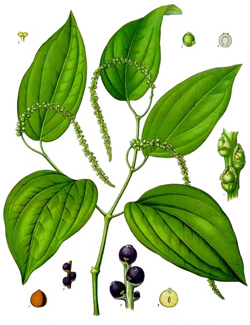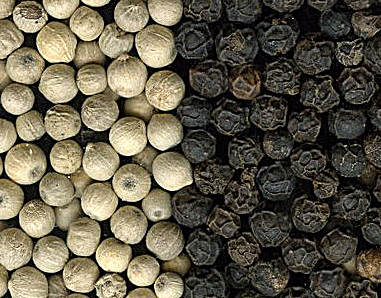

Black Pepper
Description
The black pepper (Piper nigrum) plant is a perennial woody
vine growing to six metres in height. It is a
"climber" and grows on supporting trees, poles, or
trellises.
Black pepper is native to India and is
extensively cultivated there and elsewhere in
tropical regions. Black Pepper is the worlds one of the most
traded spice so much so that black pepper has often been
referred to as the "king of spices".
Black pepper
is produced from the still-green unripe drupes of
the pepper plant. The drupes are cooked briefly in
hot water, both to clean them and to prepare them
for drying. The heat ruptures cell walls in the
pepper, speeding the work of browning enzymes during
drying. The drupes are dried in the sun or by
machine for several days, during which the pepper
around the seed shrinks and darkens into a thin,
wrinkled black layer. Once dried, the spice is
called black peppercorn. A single stem will
bear 20 to 30 fruiting spikes.
White pepper
consists of the seed of the pepper plant alone, with
the darker coloured skin of the pepper fruit removed.
This is usually accomplished by a process known as
retting, where fully ripe red pepper berries are
soaked in water for about a week, during which the
flesh of the pepper softens and decomposes. Rubbing
then removes what remains of the fruit, and the
naked seed is dried. The taste differences
between black pepper and white pepper have long been
debated the world over.

Pepper Plant with immature Pepper Corns
(Source:
http://pharm1.pharmazie.uni-greifswald.de/allgemei/koehler/koeh-eng.htm)
Growth
Black pepper needs a
minimum of 200 cms of rainfall evenly distributed.
As shade is pivotal for black pepper, plantations or
gardens are normally established in forest
clearings. Black pepper plants from runner
stems start bearing in about 3 years from planting
while rooted fruiting stems and marcotted water
sprouts start bearing a year from sprouting.
Black pepper can yield profitably from the fifth up
to the fifteenth year from planting. Harvesting
starts in February and extends till April but could
vary upon location, climate etc. Same with
yield, it depends on plant genetics, location, soil,
climate etc., and could be anything between 0.2 kgs
to 4 kgs per vine per crop.
Black pepper was a
much-prized trade good, often referred to as "black
gold" and used as a form of commodity money. The
term "peppercorn
rent"
still exists today. Black peppercorns were
found stuffed in the nostrils of Ramesses II, placed
there as part of the mummification rituals shortly
after his death in 1213 BCE. Little else is
known about the use of black pepper in ancient Egypt
and how it reached the Nile from India.
Madagascar black
pepper is one of the finest in the world and we
supply one of the best quality of Black Pepper
from Madagascar which has been carefully collected
by our farmers.
We are exporters of
black pepper of Madagascar origin only
For further
information about our black pepper like
specifications, availability, price , please
contact us
now.
Do check out the Wild
Madagascan Pepper or the
Voatsiperifery Pepper
Home

White Pepper and Black Pepper
of Madagascar











